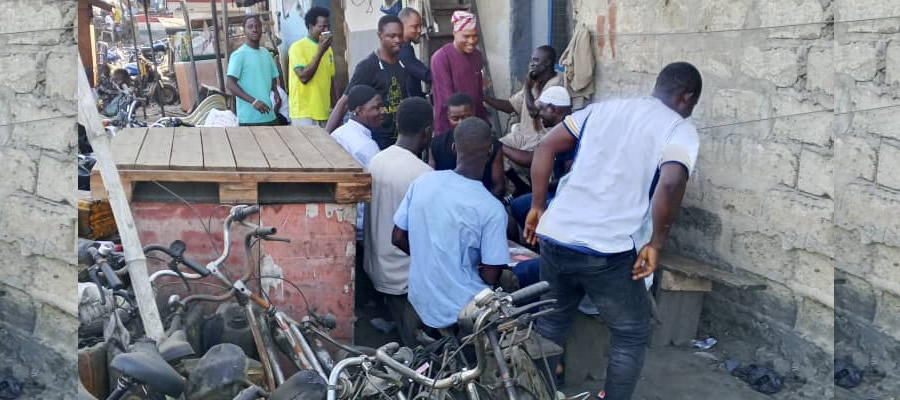

Health Infrastructure
The district has three (3) health centers situated in Wulensi, Lugni and Pudua respectively, with two Community-Based Health Planning and Services (CHPS) compounds in Nakpayili and Kukuo both in the Nakpayili sub-district.
However the District Health Management Team (DHMT) has plans to upgrade the Nakpayili Community-based health planning and services compound into a health centre due to the fact that it covers a large catchment area of twenty four (24) communities with an estimated population of 13,099, has a very high number of out patients attendants which keeps on increasing year after year and is also situated in the sub district capital. However these plans have not been realized due to inadequate staff accommodation and lack of a midwife and a general nurse.
Projects
Construction of a CHPS compound at Jollie in the Wulensi sub-district has been completed and handed over to the DHMT whilst two CHPS compounds at Mapaedo and Chando both in Lugni sub districts are almost complete and yet to be handed over. A two unit nurses quarters initiated by the former Nanumba District Assembly (N.D.A) for the staff of the Pudua health center has now been completed by the Nanumba south District Assembly (NSDA) and is now being used both as staff accommodation and for service delivery whilst the health centre is under complete rehabilitation by the Ghana Health Service (GHS).
However work at the centre which started more than a year ago has come to a stand still with less than 50% of the work done. This situation has brought an untold hardship to the staff at the centre since they have to live and work in a small space which is not conducive for the provision of quality health care. It is our hope that this situation will be resolved in the nearest possible time so that the people of Pudua which is a hard to reach area will enjoy quality health care which they deserve. Equally a two unit staff accommodation at the Wulensi health centre which was initiated by the GHS is at a stand still.
Thanks to the NSDA, during the course of the year a two bed room bungalow and a three unit staff quarters were provided for the Wulensi health centre whilst a two unit staff quarters which is being provided for the Kukuo CHPS compound is about 95% complete. The staff of these centers will now have descent accommodation. We however still appeal to the assembly for the provision of adequate staff accommodation for the Nakpayili CHPS compound and office accommodation for the DHMT. At the district capital, where the District Health Administration is situated, office accommodation is a problem and as a result the DHA is combined with the Wulensi Sub-District Health Center. This therefore deprives the centre of vital services such as laboratory and a pharmacy due to lack of space.
The DHMT is also appealing to the Regional Health Directorate to kindly assist in this direction to support provide more structures to be used as the DHA Offices and staff accommodation.
KEY ISSUES FOR 2009
• Continue the process of establishing 3 other CHPS zones
• Lobby with the District Assembly (D/A) for motorbikes for CHPS
• Establish two adolescent friendly centers in 2 facilities
• Continue the process of designating one facility baby friendly
• Strengthen the community based surveillance (CBS) system
• Improving quality of care and efficiency.
• In-service training for all categories of staff
• Promote the use of Insecticide Treated bed Nets (ITNs)
• Organize community durbars on the utilization of health services
• Organize at least 6 integrated services in HTR communities
• Sensitize chemical sellers and traditional healers to assist in the detection of TB, AFP, etc
• Train health staff & Community-Based Agents (CBA) on Community-Integrated Management Childhood Illnesses (C-IMCI)
• Lobby community water and sanitation agency through the D/A for the provision of institutional toilet and borehole for Pudua H/C
• Upgrade Nakpayili CPHS zone to a health center
• Collaborate with the D/A in organizing cleanup campaigns
• Carry out Multi Indicator Sentinel Survey(MISSS)
• Sensitize health staff, members of the D/A and other decentralized departments on regenerative health and nutrition(RHN)
SERVICE DELIVERY
DISEASE CONTROL AND SURVEILLANCE
Integrated disease surveillance and response systems grew much stronger when in the first half of the year under review, three NID’S took place with much emphasizes on AFP Surveillance.
Because of the strategic nature of the surveillance system, 32 suspected/ rumor cases of guinea worm were reported which were immediately investigated and appropriate feedback given to calm tensions and also to disassociate the rumors with guinea worm.
The district for some time now has not been able to suspect yellow fever cases despite the number of jaundice cases that passes through the system. We have realized that we can do better in that regard and hope to report on yellow fever in future.
At one stage the former Nanumba district was the number one endemic district in the country and the world at large. But due to the incomparable efforts from our Guinea worm zonal co-coordinators, village volunteers and other stakeholders not forgetting the District Assembly, there has been no reported case of Guinea worm in the district for two and half years running thereby removing guinea worm as the biggest public health problem of the district.
From July 2007 to December 2009, the district recorded zero (0) case therefore scoring 100% reduction in guinea cases.
Major activities carried out during the year include:
- Reporting and investigation of suspected cases in the district.
- Regular house to house active case search in communities that reported cases in 2007.
- Briefing stake holders about the status of the disease in the district.
- Worm week celebration; where health education in the communities in the form of talks, drama, group discussion, demonstration and counter demonstrations are carried out in selected communities.
- Sensitization of CBS volunteers, A/Cs, coaches, and Red Cross clubs on the integrated surveillance project..
MALARIA
Malaria for some years remains the number one cause of morbidity and mortality in the district most especially among children under five.
In the period under review, the total out patients department (OPD) attendance was 16,296 out of which the malaria burden for the district was 10,648 representing 65.3%. Out of the 10,648 malaria cases, 6,362 were children under five years also representing 60% of all malaria cases.
This is a remarkable increase as compared to 2008 where a total of 10,684 OPD attendants were recorded with 5,225 malaria cases representing 48.9% and out of which 2,871 were children under 5years representing 27.8%. Malaria cases keep on increasing despite the numerous activities carried out in the communities and facility level. The increase in OPD attendants and malaria cases however corresponds with an increased number of health insured clients. Since patients are only diagnosed clinically and not through laboratory examination a lot of these cases might have been misdiagnosed considering the fact that a lot of diseases mimic malaria in their presentation both in signs and symptoms. An increase in OPD attendants and malaria case corresponds with an increase number of health insured clients.
The following are some of the control activities carried out during the course of the year:
1. Health education on the importance of using insecticide treated bed nets (ITN) by pregnant women and children under five years and demonstration of treatment of mosquito nets.
2. ITN’s given to pregnant women who deliver at the clinic
3. Administration of sulphadoxine pyremethamine (SP) to pregnant women.
4. The use of Artesunate Amodiaquine and Quinine in the management of simple and complicated malaria.
5. Training of new Health Staff on Intermittent Preventive treatment( IPT)
6. Monitoring of side effects of Artesunate Amodiaquine and SP
7. Health talks/ durbars in communities on environmental sanitation with much emphasis on the breeding places of mosquitoes and the use of mosquito repellents.
The increasing burden of malaria in the district is a source of worry to the DHA. Therefore the district plans to carry out a survey before the end of the year 2010 to assess ITN utilization in the district.
Intermittent Preventive Treatment
In an effort to reduce malaria burden in the district, Intermittent Preventive Treatment (IPT) using SP is carried out at all antenatal clinics in the district. . The following expectant mothers received Sulphadoxine Pyremethamine from January to December 2009 as compared to same period 2008 and 2007.
For the year under review, a total number of 2826 pregnant women received IPT with no reported case of adverse effects. The number of women receiving IPT3 has dropped drastically due to the cost at which the Mutual Health Insurance of paying for Sulphadoxine Pyremethamine (SP) as facilities buy it at a higher cost at Regional Medical Stores while the scheme pay for it at a very reduced price and looking at the increased number of pregnant women attending ANC and having to take three dose, they were running at a loss and so could not continue to buy it for their clients.
The number of pregnant women who said they slept under ITN on 1st ANC Visit were 695 (7.3) while 965 (10%) said they slept under ITN during the 2nd visit. Coverage of utilization as reported by the women was 17.5%.
Number of pregnant women who received at least one dose of sulphadoxine pyremethamine before delivery was 213. This figure was recorded at facility level during delivery.
Artesunate Amodiaquine distribution-
Attendance at OPD has increase in the year due to NHIS. About 16,296 clients sought clinical consultation in health facilities with various conditions as against 10,684 cases in 2008 and 7,854 in 2007 respectively. Out of the 16,296 OPD cases, about 10,648 were diagnosed as having malaria and put on Artesunate/Amodiaquine. There was no reported case of adverse effect following its administration.
From January to December 2009, a total of 2360 Insecticide Treated Bed nets (ITNs.) were received from the Regional medical stores
A total of 1,400 bed-nets were received for distribution to pregnant women who come to deliver at the health facilities. About 105 women have so far benefited from the package from June this year to December 2009.
All pregnant women who attended Antenatal Care (A N C) received routine iron fesolate throughout the year. Continuing health education to pregnant and postnatal mothers to eat foods that contain iron and to sleep under ITNs is ongoing.
TUBERCULOSIS (TB)
Three sensitizing workshops on TB were organized for health workers, village volunteers, chemical sellers and prescribers in the district on the need to suspect TB cases and four cases were suspected towards the close of the year. Three out of the number were tested positive and are currently on treatment.
The district has no laboratory facilities to diagnose Tuberculosis, hence sputum specimens of suspected TB patients are sent to the Bimbilla hospital for investigation where facilities are available for diagnosis.
Twenty health staff drawn from all health facilities in the district were trained on the new TB treatment regimen and Community based TB care (CTBC) during the course of the year. Two review meetings were also held. Health education and promotion on TB at both outreach and static points were carried out, creating awareness on the signs and symptoms of the disease, its mode of transmission and prevention and also the need for early treatment. It is also emphasized that the disease is curable and at the same time preventable by vaccine during early childhood immunization.
During educational session audience were made to understand that TB was not a curse as perceived by our local people.
2.1.4
There wasn’t any mass drug distribution for filariasis under the neglected tropical diseases control programme during the year under review, due to lack of funding.
SURVEILLANCE
The ongoing systematic and regular collection, coalition, analysis and interpretation of data on the occurrence, distribution and trends of diseases with sufficient accuracy and completeness to provide basis for action (disease control) and the dissemination of information to those who need to know to take action. The surveillance system is made up of active, passive and community based surveillance.
COMMUNITY BASED SURVEILLANCE SYSTEM (CBS)
Community based surveillance (CBS) continues to be one of the major areas which provide us with invaluable information emanating from the community level as the name suggest. Community based health workers otherwise known as community base health volunteers and TBAs together with community based agents (CBA’S) who are in the Community-Integrated Management of Childhood Illnesses (C-IMCI) continue to play significant roles in the surveillance system in the district.
The CBS system recorded a total of 2,285 live births with 14 infant deaths providing an infant mortality rate (IMR) of 6/1000 live births as compared with 2,101 live births, 57 infant deaths and infant mortality rate (IMR) of 27/1000 live births in 2008. In the year under review, the district chalked a lot of successes in the areas of infant and maternal mortality and a suggestive reason was that Durbars were held in communities that reported more than one infant and maternal deaths and feedback on causes of death were given and discussions on how to prevent these deaths together with the need to bring their infant for immunization, the warning signs pregnancy and the importance of coming to the clinic to deliver. Fortunately too the district did not record maternal mortality this year as compared with 1 in 2008.
EXPANDED PROGRAMME ON IMMUNIZATION (EPI)
Expanded programme on immunization (EPI) has proved as a corner stone in the primary health care strategy. It is a cost-efficient intervention that prevents nine (9) common childhood diseases; poliomyelitis, measles, diphtheria, neonatal tetanus, whooping cough, tuberculosis, hepatitis B, haemophilus influenza type B and yellow fever.
EPI is not only important because it seeks to prevent child mortality and morbidity due to vaccine preventable infections but it is also an important entry point for many significant public health interventions within the communities.
It has been estimated that without immunization, 3% of all children will die from measles, 2% from whooping cough, 1% from tetanus and 0.5% will be crippled by poliomyelitis for the rest of their lives. “The role of the EPI manager, First edition, February 2002”
The district has a total population of 65,477 (projected from the 2000 population census) of which 2,619 are children under one year. The district has only seventeen (17) health and seven support staff that carry out EPI activities with five (5) static immunization centers of which four (4) double up as the sub-districts capitals and health facilities and one as a CHPS compound. Each of the centers has at least two motor bikes which are used for EPI and other programme activities.
EPI activities are favored during the dry season; this is because most of the communities in the district are cut off during the raining season. Because of this some of the communities were not visited at one point in time depending on the prevailing situation.
In the last half of the year, thanks to GAVI the district was able to mobilize to cover areas that were not assessed during the raining season which culminated in the districts performance in all the antigens.
TT2+ coverage for the year under review is 9.1% representing 1,431 pregnant women who came to antenatal clinic and received TT2+ immunization that notwithstanding the District recorded a TT2+ status of 88.4% also representing 13,897 women in child bearing age who have received two and above TT doses.
All the sub-districts performed very well in all the antigens, reflecting in the performance of the district. In the previous years it was found out that there was improper documentation . Women who have already taken TT2 in their previous pregnancy were given TT again and recorded as TT1. Trainings were organized for health staff to curtail future occurrence which have paid much dividends in the year under review.
TT2+ coverage for the year under review is 9.1% representing 1,431 pregnant women who came to antenatal clinic and received TT2+ immunization, that notwithstanding the district recorded a TT2+ status of 88.4% also representing 13,897 women in child bearing age who have received two and above TT doses.
The 13,897 women were those that received TT2+ and those who came to antenatal but were not give TT immunization that have previously received more than two TT doses.
Date Created : 11/18/2017 7:32:54 AM










 facebook
facebook
 twitter
twitter
 Youtube
Youtube
 +233 593 831 280
+233 593 831 280 0800 430 430
0800 430 430 GPS: GE-231-4383
GPS: GE-231-4383 info@ghanadistricts.com
info@ghanadistricts.com Box GP1044, Accra, Ghana
Box GP1044, Accra, Ghana